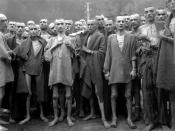Although we cannot compare the horrors of the Nazi Concentration camps to the American "Relocation Centers", there are many similarities. Both of the groups of victims were of the minorities, and these cultures were somewhat of an enemy to the leader of their country. These groups (the Japanese in America nearly two thirds of which were American citizens, and the Jews, Gypsies, the Poles, Slovaks, Communists and other enemies of the state in Germany and Poland, many of which had served the very countries who were persecuting them during World War One) were all unjustly and unfairly treated for many years, until the liberation of the Concentration camps, and the release of the prisoners in the 'relocation centers'.
While some may argue that the Japanese in these internment camps were treated fairly, many returned to their houses after their captivity to find another (white) family living in them, and all of their belongings gone.
But while the Japanese were in the camps, they were given enough food to live on, and lived in a quasi-communist environment, which is ironic considering the "anti-red" hatred and fear that was sweeping across the US. In the case of Manzanar, which is in the Sierra Nevada's, the interned were given one bunk in a large tar-paper barrack for each family, equal but small rations of food each week, and the able-bodied were given menial jobs that they were not paid for (i.e. building more barracks, although they had attended law school or had studied medicine.) (http://thesierraweb.com/lonepine/manzanar.html) But according to the aforementioned website, "The camp was surrounded by barbed wire." and "Guards with machine guns were posted at watchtowers, with orders to shoot anyone who tried to escape." These quotes were said by former California Congressman Norman Mineta, who was 10 years old when he...


